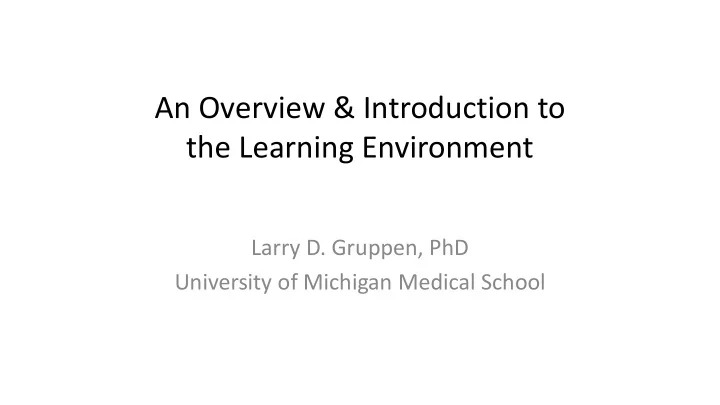

An Overview & Introduction to the Learning Environment Larry D. Gruppen, PhD University of Michigan Medical School
Framing the Topic • All of you live in a learning environment. – How would you describe it? Is it good? Bad? – What are the key features? – How does it “work”?
Framing the Topic • Imagine you wanted to understand the LE so you could make it better – What else would you want to know about the LE? • Exploratory research question (hypothesis generating) – What interventions might you try? • Experiment question (hypothesis testing)
First Things • Definitions – Dependent and independent variables – Key terms and concepts • Theory – What things matter and what can be ignored – How things work together • Measurement – Can’t do research without measuring variables and concepts – Not just quantitative, but qualitative as well
Definitions • Descending from the Middle French preposition environ “around,” environment, in its most basic meaning, is “that which surrounds” • A social system that includes the learner (including the external relationships and other factors affecting the learner), the individuals with whom the learner interacts, the settings and purposes of the interaction, and the formal and informal rules/policies/norms governing the interaction AMA 2007
Definitions • The learning environment refers to the social interactions, organizational culture and structures, and physical and virtual spaces that surround and shape the learners’ experiences, perceptions and learning. Josiah Macy Jr Conference, 2018
Features of the Learning Environment • Physical facilities • Leisure time • Class size • Curricular interventions • The faculty • Grading systems • Relationships with peers • Institutional culture • Teacher competence • Assessment methods and frequency • Group size • Clinic settings • Patient population • What ISN’T part of the learning environment?
Synonyms and Related Terms • Educational climate, social environment, psychological climate, work environment • Context – Context as a target of learning, e.g., understanding the patient’s psychosocial context, the context students learn about, part of the curriculum – Context as influence on learning, the context students learn in, non- curricular, learning environment
Theoretical Lenses 9
Lens: Curriculum vs. LE Intentional Unintentional Content of Official Hidden learning curriculum curriculum Context of Official Hidden learning learning learning environment environment 10
Lens: Gruppen, Irby, Maggio, Durning (2018) • Sociocultural Dimension – Organization (sociology) – Social (social psychology) – Person (psychology) • Spatial Dimension – Physical environment and learning affordances • Technology Dimension – Virtual learning spaces
Personal Level 13
Social Level 14
Organizational Level 15
Physical Space
Virtual Space
Measuring the Learning Environment 18
Measuring the LE • Numerous instruments in medical education • Three recent systematic reviews of instruments (Soemantri, et al., 2010; Schönrock-Adema, et al., 2012; Colbert-Getz, et al., 2014) • (Almost) all are questionnaires completed by learners – Learner reports of their personal perceptions -> solipsism? • Differences in target setting and item focus
Illustrative Items • My work tasks are relevant to the learning objectives. (Org) • I feel I have influence over my learning in this placement. (Org) • Supervisors, nursing staff, other allied health professionals and residents work together as a team here (Soc) • My program director reserves time to supervise/counsel me (Soc,Org) 20
Fixing the Learning Environment
Change the Curriculum • Effect of curriculum change on student perceptions of the learning environment . Robins, et al., 1996 • Single institution, major curriculum change – Department- to organ-based structure, small groups, case-based, p/f grading, extensive use of SPs, formative feedback, etc. – Found a moderate to large effect size advantage of new over old curriculum LE – What made the difference? Impossible to tell
Satisfied Faculty • Key factors in work engagement and job motivation of teaching faculty at a university medical center . van den Berg, et al., 2013 • National survey of university medical center faculty, engagement in teaching predicted by: – teaching about my own specialty – noticeable appreciation for teaching by my direct superior – teaching small groups – feedback on my teaching performance – freedom to determine what I teach
Faculty Development • Faculty as contributors to and recipients of the learning environment • They represent the personal, group, and organizational levels of the environment – often the societal level as well • Faculty development for LE improvement not necessarily the same as faculty development for teaching skills
Reduce Student Mistreatment • AAMC definition and student interpretation • Punitive vs appreciative perspective on LE • One event represents entire LE • Like questionnaires, still student defined
Build Learner Community • The social component of the LE • Promote cooperation rather than competition • Promote more interaction with faculty members • Coercive element to participation (e.g., required reflections) may have unintended consequences
Space • New medical education buildings proliferate • Partially, a recognition that the physical environment matters • Not just architecture, but a value statement • Cannot ignore the ‘hidden’ learning spaces: Starbucks, home, private, group
Some Conclusions • Social science and educational phenomena are typically complex – Many inter-related influences that are difficult to measure • Learning environment is particularly challenging – Definition varies by learning target and situation – Measurement is problematic – Challenging to include variables from each of the key dimensions of our theoretical model
Nonetheless… • The LE is critical to issues of stress, burn-out, suicide, productivity, patient care • Failures in the LE can be expensive (e.g., regulatory consequences, legal actions) • Cannot ignore or neglect it just because it is messy • Changing the LE requires a clear definition of the starting point and goal
Recommend
More recommend